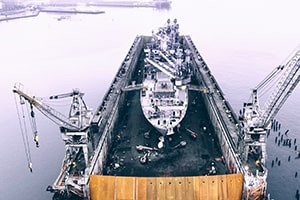We have all seen movies where ships sink or float depending on the damage. This introductory course on ship construction and bulkheads gives you a better insight into why this happens. We will first introduce you to the definition of ship construction, the historical background of vessels and the rapid growth and development in hydro-kinetics. You will also learn about hydrostatics and the science of materials, leading to increased size, speed, commercial value and safety of ships. Investigate the constructional features of the ship’s structure and the terms used for dimensions and structure. Explore the components used to frame a vessel, which includes frames, beams, transverses, floors, stringers, longitudinals and girders. Discover basic hull ship designs commonly used, together with their structural cross-section. The concept of general cargo ships, with the type of cargo carried by these ships, will also be covered in this course.
This course then explains the two primary standards for measuring cargo and determining the freight payable and cargo-carrying capacity. The importance of proper cargo stowage to avoid damage during a voyage, precautions to prevent damage to cargo and dunnage are all factors that you must consider. This course will teach you about cargo hold inspection, preparation of the hold, requirements for loading and precautions to be taken when handling heavy lift cargo. There are two types of ventilation: natural and mechanical. Both are discussed and we examine the concept of hold ventilation. Are you curious about oil tankers, bulk and combination carriers and the features and functions of a container, roll-on roll-off and passenger ships? You’ll become acquainted with these vessels and be taught about static and dynamic forces, hogging, sagging and static stresses. We outline the concepts of dynamic, slamming and torsional stresses, including the structural elements of a ship’s hull like deck plating, transverse bulkhead, transverse frame, keel frame and hull side beam.
Furthermore, this course will help you gain knowledge of the standard steel sections, which include H or I sections. The definition of bulkheads and their divisions as Class A, B and C are clarified. Become aware of the features and functions of the three basic types of bulkheads: watertight, non-watertight and tank. This course will help you understand the importance of testing watertight bulkheads, features of longitudinal bulkheads and the regulations governing the number and position of watertight bulkheads. This course will be of great interest to students, researchers and anyone interested in constructing ships. So register for this course and become an authority in ship construction.
What You Will Learn In This Free Course
View All Learning Outcomes View Less All Alison courses are free to enrol, study, and complete. To successfully complete this Certificate course and become an Alison Graduate, you need to achieve 80% or higher in each course assessment.
Once you have completed this Certificate course, you have the option to acquire an official Certificate, which is a great way to share your achievement with the world.
Your Alison certificate is:
- Ideal for sharing with potential employers.
- Great for your CV, professional social media profiles, and job applications.
- An indication of your commitment to continuously learn, upskill, and achieve high results.
- An incentive for you to continue empowering yourself through lifelong learning.
Alison offers 2 types of Certificate for completed Certificate courses:
- Digital Certificate: a downloadable Certificate in PDF format immediately available to you when you complete your purchase.
- Physical Certificate: a physical version of your officially branded and security-marked Certificate
All Certificate are available to purchase through the Alison Shop. For more information on purchasing Alison Certificate, please visit our FAQs. If you decide not to purchase your Alison Certificate, you can still demonstrate your achievement by sharing your Learner Record or Learner Achievement Verification, both of which are accessible from your Account Settings.











 Avg. Hours
Avg. Hours  Contains Video
Contains Video  CPD Accredited
CPD Accredited 
 Total XP:
Total XP: 
 Knowledge & Skills You Will Learn
Knowledge & Skills You Will Learn 







